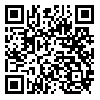

Volume 27, Issue 1 (Winter 2020)
Intern Med Today 2020, 27(1): 2-17 |
Back to browse issues page
Download citation:
BibTeX | RIS | EndNote | Medlars | ProCite | Reference Manager | RefWorks
Send citation to:



BibTeX | RIS | EndNote | Medlars | ProCite | Reference Manager | RefWorks
Send citation to:
Pouryousef F, Navidian A, Rafizadeh Ghahdarijani O, Yaghoubinia F. Comparing the Effect of Virtual Reality and Rhythmic Breathing on the Anxiety of the Patients Undergoing Coronary Angiography. Intern Med Today 2020; 27 (1) :2-17
URL: http://imtj.gmu.ac.ir/article-1-3455-en.html
URL: http://imtj.gmu.ac.ir/article-1-3455-en.html
1- Department of Critical Care Nursing, Zahedan University of Medical Sciences, Zahedan, Iran.
2- Pregnancy Health Research Center, Zahedan University of Medical Sciences, Zahedan, Iran.
3- Department of Cardiology, Medical School, Zahedan University of Medical Sciences, Iran.
4- Community Nursing Research Center, Zahedan University of Medical Sciences, Zahedan, Iran. ,yaghoubinia@gmail.com
2- Pregnancy Health Research Center, Zahedan University of Medical Sciences, Zahedan, Iran.
3- Department of Cardiology, Medical School, Zahedan University of Medical Sciences, Iran.
4- Community Nursing Research Center, Zahedan University of Medical Sciences, Zahedan, Iran. ,
Abstract: (4559 Views)
Aims: Coronary angiography is a stressful procedure for patients, and about 80% of the patients have expressed their anxiety before angiography. The current study aimed to compare the effects of virtual reality and rhythmic breathing on the anxiety of patients undergoing coronary angiography at the hospital of Ali-Ibne Abitaleb in Zahedan City, Iran, in 2019.
Methods & Materials: This clinical trial study was performed on 90 patients hospitalized in the Cardiac Care Unit of Ali-Ebne Abitaleb Hospital in Zahedan in 2019. The study subjects were selected by convenience sampling method and randomly assigned into three groups: virtual reality, rhythmic breathing, and control. Anxiety was measured before, half an hour, and one hour after the intervention by Spielberger questionnaire. The obtained data were analyzed in SPSS v. 16. Data analysis was performed by repeated measures ANOVA and the Chi-square tests at a significant level of 0.05.
Findings: The Mean±SD scores of the anxiety of the research samples before the intervention in the virtual reality, rhythmic breathing, and control group were 57.56±7.82, 57.10±6.49, and 56.33±6.74, respectively. The Mean±SD scores of the anxiety of the research samples 1 hour after the intervention in the virtual reality, rhythmic breathing, and control group were 42.30±7.46, 47.46±6.14, and 55.93±6.47, respectively. The repeated measures ANOVA showed a significant difference between the anxiety in the three groups during the intervention (P˂0.001). This difference was between the control group with the virtual reality group (P˂0.001) and the rhythmic breathing group (P=0.004). Thus, reducing the research samples’ anxiety during the intervention was significantly more in the virtual reality and rhythmic breathing group than the control group.
Conclusion: The results showed that virtual reality and rhythmic breathing lead to reduced anxiety in patients undergoing angiography. The application of these methods is suggested as they are non-invasive, inexpensive, without complications, and easy to implement.
Methods & Materials: This clinical trial study was performed on 90 patients hospitalized in the Cardiac Care Unit of Ali-Ebne Abitaleb Hospital in Zahedan in 2019. The study subjects were selected by convenience sampling method and randomly assigned into three groups: virtual reality, rhythmic breathing, and control. Anxiety was measured before, half an hour, and one hour after the intervention by Spielberger questionnaire. The obtained data were analyzed in SPSS v. 16. Data analysis was performed by repeated measures ANOVA and the Chi-square tests at a significant level of 0.05.
Findings: The Mean±SD scores of the anxiety of the research samples before the intervention in the virtual reality, rhythmic breathing, and control group were 57.56±7.82, 57.10±6.49, and 56.33±6.74, respectively. The Mean±SD scores of the anxiety of the research samples 1 hour after the intervention in the virtual reality, rhythmic breathing, and control group were 42.30±7.46, 47.46±6.14, and 55.93±6.47, respectively. The repeated measures ANOVA showed a significant difference between the anxiety in the three groups during the intervention (P˂0.001). This difference was between the control group with the virtual reality group (P˂0.001) and the rhythmic breathing group (P=0.004). Thus, reducing the research samples’ anxiety during the intervention was significantly more in the virtual reality and rhythmic breathing group than the control group.
Conclusion: The results showed that virtual reality and rhythmic breathing lead to reduced anxiety in patients undergoing angiography. The application of these methods is suggested as they are non-invasive, inexpensive, without complications, and easy to implement.
Type of Study: Original |
Subject:
Basic Medical Science
Received: 2019/12/31 | Accepted: 2020/06/27 | Published: 2021/01/1
Received: 2019/12/31 | Accepted: 2020/06/27 | Published: 2021/01/1
| Rights and permissions | |
 |
This work is licensed under a Creative Commons Attribution-NonCommercial 4.0 International License. |





